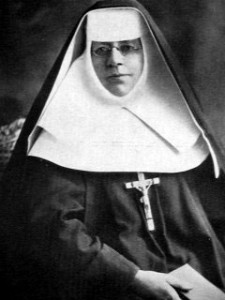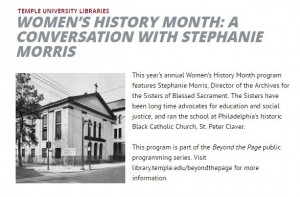 I attended an event about the Sisters of the Blessed Sacrament presented by Stephanie Morris, the archive director of the collection. The event was held at the Blockson Collection on Temple’s campus, on 16 March, 2016.
I attended an event about the Sisters of the Blessed Sacrament presented by Stephanie Morris, the archive director of the collection. The event was held at the Blockson Collection on Temple’s campus, on 16 March, 2016.
The Sisters of the Blessed Sacrament was founded in 1891 by Mother Katharine Drexel as a Catholic religious institute. The original name included “for Indians and Colored People,” which Morris made considerable note of and drew attention to as an example of the now-archaic language and terms of the nineteenth century. There were no more than 20 people in attendance, most of them much older, and only one or two other young students.
The beginning of the presentation was loaded with facts about Katharine Drexel’s family tree, which was helpful in order to have an idea of where her family came from, but I felt that it dragged on a bit too long with countless names of people who had little to do with the organization that the presentation was about. Throughout all of the naming, though, Morris tended to focus mainly on the women of the Drexel family, and even left out the name of Anthony Joseph Drexel, either in the spirit of Women’s History Month or because she felt the audience would have this knowledge already.
She talked a lot about Katharine Drexel’s upbringing: Drexel was homeschooled and very educated, extremely wealthy by way of the inheritance of her father Francis Drexel’s $15 million estate, and an astute businesswoman. Some of the inheritance was donated to various charities and orphanages; Morris explained that Katharine was “very exposed to the pov erty of others,” but it wasn’t until later that I learned in what capacities she interacted with the less fortunate. Her father sat on the board of nearly every Catholic charity in the city of Philadelphia, and her stepmother, Emma Bouvier, opened up the Drexel’s home three afternoons per week to anyone in need.[1]
erty of others,” but it wasn’t until later that I learned in what capacities she interacted with the less fortunate. Her father sat on the board of nearly every Catholic charity in the city of Philadelphia, and her stepmother, Emma Bouvier, opened up the Drexel’s home three afternoons per week to anyone in need.[1]
One criticism I have of the presentation is that Morris did not explain Katharine’s motivations for the work that she did, which I feel would have allowed the audience to understand her life and personality better. For example, we were told that in 1889, Drexel joined the Sisters of Mercy Convent in Pittsburgh to begin her postulancy, but were not informed of the reasons for her decision. After Emma Bouvier died (leaving a cryptic letter about the door to Jesus’s heart being open to those who knocked), the still-grieving Drexel family took a trip to Europe. In Rome, they met two priests whose mission was to Native American tribes in the Northwest, and Katharine was moved by their descriptions of the poverty of the Indians and committed herself to their betterment and education.[2]
Shortly after, Francis Drexel died, and Katharine and her sisters combined his banking skills with their mother’s “hands on approach to charitable concerns” in order to carry out their parent’s legacies. After a meeting with the pope who recommended she herself become a missionary instead of searching for recruits to work the mission for her, Katharine’s devoted her life to service.
Other than the small oversight on motivations, I thought the presentation was strong. The Sisters of the Blessed Sacrament was formed in 1891 and on their various missions around the U.S. helped set up schools for blacks and Native Americans that, from what I heard, had an overall positive effect on the individuals they served. It would have been interesting to have a discussion about the effects of Christian missionaries on the communities they traveled to, and to hear about the cumulative effects of the Sisters of the Blessed Sacrament (roughly how many children were educated, what some of them did after leaving the programs, etc.).
REFERENCES
[1] Cecilia Murray, “Katharine Drexel: learning to love the poor,” Catholic Education: A Journal of Inquiry and Practice 9.3 (2006): 307-319, accessed March 22, 2016, 308.
[2] Ibid., 310.
